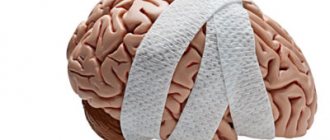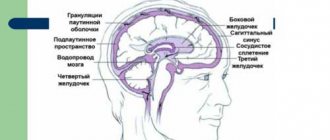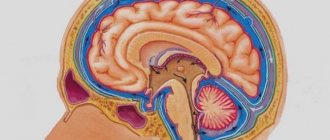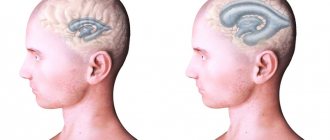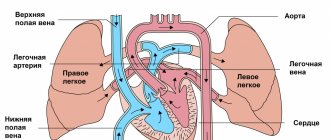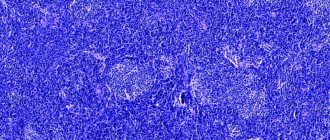Concussion in children and adults is a common traumatic brain injury. A wide range of drugs are now being produced aimed at treating pathologies. However, Diacarb is most often used for concussion.
This medicine belongs to the group of diuretics, reduces swelling of the brain that occurs during a concussion. The use of the drug improves the patient's prognosis for recovery. The medicine is prescribed by a neurologist after a thorough examination of the patient and additional examination methods.
General information and mechanism of action of Diacarb
Diacarb shows good results in cases of concussion due to its diuretic effect. The medicine blocks an enzyme in the renal tubules, increasing the excretion of sodium and potassium ions in the urine, which leads to increased diuresis and the removal of excess fluid from the human body. It is this mechanism of action that causes a decrease in the intensity of cerebral edema and reduces the risk of developing complications of traumatic brain injury.
The average duration of effect from taking the medicine is 12 hours, after which the diuretic activity of Diakarb is significantly reduced.
All about head injuries in children: what to do to avoid them.
Read about concussion symptoms: what you need to know?
Indications and contraindications for use
Diacarb for concussion in children and adults is the most important drug in the treatment regimen. It is prescribed to patients who have no contraindications to its use. In addition, the drug is used to treat edema syndrome of any cause.
Contraindications to the use of the medicine:
- individual intolerance to the active substance or components of the drug, as well as allergic reactions to administration;
- severe kidney dysfunction, manifested by acute renal failure;
- liver dysfunction;
- decreased level of potassium in the blood, acidosis;
- period of pregnancy, lactation.
If a patient with a concussion has contraindications, they refuse to prescribe medication and choose similar drugs, the effect of which is manifested by a decrease in swelling of body tissues.
Concussion in a child
Concussion in children is a mild degree of TBI, accompanied by minor functional disorders of a transient nature without compromising the integrity of the skull bones. A concussion in children occurs with a short-term disturbance of consciousness, vomiting, and pale skin, which are later replaced by headache, dizziness, lethargy, tinnitus, and pain in the eyeballs. If a concussion is suspected, children are advised to consult a traumatologist and neurologist, carry out NSG, EchoEG, EEG, and skull radiography; according to CT (MRI) of the brain, lumbar puncture. Therapeutic tactics for concussion in children include hospitalization, rest, local hypothermia, dehydration, sedation, and nootropic therapy. Symptoms
In infants, the symptoms of a concussion are difficult to identify. After a stroke, vomiting, pale skin, regurgitation after eating, restlessness, moodiness, sleep disturbances, and prolonged crying may occur. In older children, trauma is accompanied by headache and dizziness, nausea and vomiting, weakness, disorientation in time and space, inability to concentrate, and changes in pulse. A short-term loss of consciousness is possible. When the child comes to, he is disturbed by a feeling of stupor. Sometimes a concussion in children is diagnosed with post-traumatic blindness, which can develop either immediately or some time after the injury. It lasts from several minutes to several hours, after which it disappears on its own. The reason for this phenomenon has not yet been studied. The consequences of the injury may not appear immediately, but after a couple of hours. The condition worsens sharply: fainting, nausea and vomiting are observed. In this case, immediate medical attention is required. For a month or two after a concussion, the child will likely complain of motion sickness in transport, but gradually this symptom will pass. A distinctive feature of childhood concussions is that immediately after the injury, there may be no symptoms. They appear after some time, their strength quickly increases, which is why it is so important to observe the child over the next few hours.
Treatment
Helping your child is about creating a calm environment. You need to put the baby to bed and provide him with peace. If there is bleeding from the wound, treat it and bandage it if possible. In addition to diagnostic procedures, the hospital’s emergency room treats injuries to the soft tissues of the head (bruises, abrasions, wounds). Children, especially young children, with a confirmed traumatic brain injury, including a concussion, are subject to mandatory hospitalization. Hospitalization has several purposes. Firstly, for several days the child is under the supervision of doctors in a hospital setting for early detection and prevention of complications of injury - cerebral edema, the appearance of intracranial hematomas, epileptic (convulsive) attacks. The likelihood of these complications is low, but their consequences are extremely severe and can lead to a catastrophically rapid deterioration of the child’s condition. Therefore, for a concussion, the standard hospitalization period is a week. With good technical equipment of the hospital (computed tomography, neurosonography), which makes it possible to exclude more severe brain damage, the length of stay in the hospital can be reduced to 3-4 days. Secondly, during hospitalization the patient is provided with the creation of psycho-emotional peace. This is achieved by limiting the child’s motor and social activity. Of course, it is difficult to achieve complete bed rest for children, but still, hospital conditions do not allow running around, noisy games, watching TV for a long time, or sitting at the computer. After discharge, the home regimen is maintained for another 1.5-2 weeks, and sports activities are limited for several weeks. Drug therapy for concussion has several goals. First of all, the child is prescribed diuretic drugs (most often DIACARB, less often FUROSEMIDE) in mandatory combination with potassium drugs (ASPARKAM, PANANGIN). This is done to prevent swelling of the brain. Calming therapy is carried out (PHENOSEPAM, VALERIAN ROOT INDUSTRY) and antihistamines are prescribed (SUPRASTIN, DIAZOLIN, DIMEDROL). For headaches, analgesics (BARALGIN, SEDALGIN) are prescribed, and for severe nausea - CERUKAL. At a later date, nootropic drugs that improve metabolic processes in the brain and vitamins may be prescribed. Monitoring of the children's condition is carried out by the attending and duty doctors, as well as by guard nurses. In case of any deterioration, the child is re-examined and additional diagnostic tests (neurosonography, computed tomography, EEG) are prescribed.
No information posted on this or any other page of our website can serve as a substitute for personal contact with a specialist. The information should not be used for self-medication and is provided for informational purposes only.
The site is maintained by pharmaceutical and medical professionals.
Dosages
The use of Diakarb for traumatic brain injuries is carried out according to the following scheme. After a pathology is detected in a patient, the drug is prescribed in high therapeutic dosages - 250 mg per day, or 130-250 mg 2 times a day.
If the prescribed dosages do not lead to a clinical effect, the attending physician increases the dose to 750 mg per day. However, in this situation, constant monitoring of the patient’s condition is necessary, especially control of the urinary system due to the risk of kidney damage.
Important! Increasing the dosage above 750 mg per day is not advisable, since the diuretic effect does not increase, only the risk of side effects increases.
Use of the drug for more than 5 days increases the risk of acidosis with a metabolic component, so the duration of therapy should be strictly limited. Only the attending physician should prescribe the drug after a full clinical examination of the patient and the use of special methods for assessing renal function to identify hidden renal failure.
diacarb and asparkam for concussion
Hello! I would really like to know where to look for the truth and how to achieve justice. I'll start with the latest events.
On June 24th my child fell out of his walker. He leaned over the edge and fell sideways onto the floor along with his walker. Fell on the bathroom floor. He stood, watched me wash his pants and tried to move in (apparently to help me))), but the threshold of the bathroom became an obstacle (it is about 10 cm high), and my son fell along with his walker onto the lenoleum in the bathroom, under which there is concrete (old chipped tiles). My child fell from a height of approximately 40 cm. The result of the fall: two bruises the size of a ruble coin: one on the right side of the forehead, the other on the right cheekbone with a little scratches, but there was no blood. Yes, the child got scared and cried. I calmed him down in less than 10 minutes. Of course I was shaking, I was scared myself. I am an impressionable person, I was very worried about this. This happened around 11 o'clock in the morning. Because At that time we went to the Center for Restorative Medicine and Rehabilitation (dalle Center) for massage and gymnastics (we had our first lesson on the 23rd), I decided to wait until 14-00 (at that time we attended classes at the Center) and consult a neurologist, which to do in such a situation. I knew that children with bruises were not accepted there; they needed confirmation that they did not have a concussion (and even with the most minor bruises, for example, after an unsuccessful encounter with a bed stick). My child is 11 months old, he is white-skinned, bruises can appear even if you grab his hand a little harder. Anyone who has children will understand me. A boy without bruises at this age is probably nonsense!
And so we came to the Center. When they came into the neurologist’s office and I told him what happened, the doctor made wide eyes and was surprised why I didn’t call an ambulance. I explained that I myself was confused and didn’t know what to do in such situations (this is my first child), to which she told me that I was a bad mother and that “walkers are made for lazy mothers.” For information: an orthopedist advised us to buy a walker when we came to her for an examination at 9 months. The neurologist also asked how long ago I put my child in a walker and why. When I said that I needed to do the laundry, she replied: “You have to do the laundry when the baby is sleeping and do all the work when he’s sleeping. And when he’s awake, you can’t leave his side, that’s actually why I was given maternity leave.” Yes, I understand all this, but what should I do? Should I not have bought a walker at all and washed my pants when everything was already dry? In general, we all grew and fell, and got bruises and nothing - we grew up. I myself personally fell badly as a child and broke my lip (I still have a small scar), but despite this I grew up as a healthy child and graduated from school with a silver medal and then from university. And they painted in bright colors that I almost made a fool of my child by putting him in a walker. Moreover, the walkers were specifically chosen to be stable, not round, rectangular, with 8 wheels. So, the neurologist suggested that I call for “transportation” and sent us for examination to the regional hospital. The so-called “transportation”, but in fact the ambulance took 1 hour and 20 minutes. While I was sitting in our neurologist’s office, I listened to the fact that she “is responsible for the health of my child, not for my things” and my health, as I understand it... Because. We have no relatives in the city, my husband and all my friends work on weekdays, I had no one to pick up the stroller from the Center, to which they told me: “That’s your problem.” I had to call my husband from work, although, as it turned out later, the stroller could have been left in the stroller even until the morning, because... it is locked in the evening (this was suggested to me by the reception staff of this Center. In general, having heard enough about what a bad mother I am and that we are being discharged from the center, interrupting the course of treatment, and will be reinstated only after 2-3 months (more precisely, I needed to go there again sign up and wait another 2 months to get there), my nerves could not stand it and I burst into tears. The Center staff told me that every second mother leaves this neurologist in tears (this is how doctors know how to preserve the health of our children and their parents!!! ) As it turned out, all the problems could be solved peacefully and without any nerves. Calling me a bad mother, etc., the neurologist did not think about the fact that I could feel bad or worse... And she is a doctor! She took the Hippocratic oath! Result: After 1 hour and 20 minutes we were traveling in an ambulance to the regional hospital, where, as the ambulance doctors said, if they don’t accept us (and apparently they wouldn’t accept us??? With a small child!!!), then we would have to get there We'll go on our own. Well, of course, they're not taxis!!! Fortunately, by that time our dad had already asked to leave work, took the stroller and was already driving towards the regional hospital to pick us up. After waiting in the doctor’s waiting room for about forty minutes, we were examined and sent for an x-ray to another building. There we were almost sent back without understanding why we were sent, although I had the directions in my hands and I showed them!!! From the woman who did the x-ray, I also heard that I was a bad mother and “why did I even buy a walker for my child???” So, it would seem to her, what does it matter? Do your job and that's it! She scolded me for holding the baby poorly, and I held him poorly because she didn’t explain well how to hold it (I don’t go for x-rays with my child every day, if that’s the case!). Having received the result, we went back to the emergency department, where we waited for a long time for the doctor... The doctor came out and explained that the X-ray showed the absence of fractures and displacements, the ultrasound at the Center also showed everything was fine, BUT!!! “For young children, a concussion is diagnosed based on the fact of a FALL, because... they can’t tell whether something hurts or not.” This is all despite the fact that we had no vomiting or loss of consciousness and the child ate normally after the fall, slept and behaved as usual. The doctor suggested hospitalization. I, already in a state of extreme nervous stress, agreed. Having registered and gone up to the department, I waited another half hour for the nurse who would receive us. I was sitting near the post and at that time I was slowly horrified by the sight of the second pediatric surgery department of the regional clinical hospital in the city of Ivanovo! Firstly, I went there without any shoe covers or other shoes, in outerwear, no one paid attention to this in principle. The walls and floors of this department inspired horror: I couldn’t wrap my head around how children could be there. The walls are all shabby, although with drawings from Soviet times. In some places the paint simply fell off, and in others, along with the plaster, the lenoleum consisted entirely of patches, or even the wooden or concrete floor (there was no time for details anymore) was visible. But despite all this, the doors to the department were made of plastic, i.e. You can't tell from the outside what kind of nightmare is hidden behind them. (I immediately remembered Ivan Khrenov).
It was already about six in the evening, and by that time my child was already very hungry and sleepy. A nurse came and directed us to ward No. 34, after asking the mothers there if there was a free bed there! Note that she didn’t look in her notes, she asked people who had nothing to do with the regional hospital! When I entered the ward with the child, I was even more horrified: the bed where I needed to stay for at least 9 days (according to the doctor) was covered with gray, terrible sheets that were not the freshest. But this is nonsense, above the bed, at a height of 20 centimeters, there were 2 wires sticking out. The ends were wrapped with an ordinary paper napkin (this was most likely done by the mothers of the children who were lying there). My child immediately began to crawl on this bed and reached for the wall, and at that moment I needed to get something to feed him. And how to hold a child without being electrocuted and at the same time trying to get something from food was not possible. We were not provided with a cot because they “were all dismantled and no longer exist.” I believe that I had to sleep on this single bed with the child: the child, as I understand it, was against this cold wall with wires. And above our bedside table, also hanging about 20 centimeters away, were two holders for the sink, which had apparently been moved behind the partition at some point, but they forgot to remove the holders. And this is a ward for staying with children!!! My head was already bursting with pain. My blood pressure jumped a lot.
Fortunately, by that time my husband had brought us food and I went downstairs with the child and the bag - in general, with everything I had and went outside. When my husband heard the conditions in which they wanted to keep us for 2 weeks (at least as the nurse said), we had no doubt that we needed to leave here. As a result, I went upstairs, fortunately I left the child with my husband (by the way, I left the department and the building in general almost unhindered), went up to the nurse and said that I wanted to write a refusal.
The nurse and I wrote a refusal, then she said that I needed to go to the resident’s room. It was difficult for me to understand where she was, and they refused to accompany me, saying “I have my own business.” In general, I was shocked, simply SHOCKED by the regional hospital!!!
The doctor turned out to be the one who examined us upon admission, again explained to me all the consequences of a “concussion due to a fall,” etc. When asked if we could go home for the night, I was told that the surgery does not have a day hospital and I need to stay there with the child around the clock, and this despite the fact that a concussion may not have occurred. But the FACT OF THE FALL remains a fact, so we came out with a note stating that we did receive a concussion and we were prescribed treatment. I don’t want to say anything bad about the doctor at the regional hospital: she’s young, she explains everything in normal language, but in addition to treatment, my child was prescribed a one-time injection. What kind of injection, I asked the nurse, she said that it was an anesthetic and sedative. Why do I say to inject him, if the child no longer has any pain or tears, he fell in the morning!? “And everyone is injected with it when they come to us,” answered the nurse. It turned out that this injection of analgin with diphenhydramine was a normal Soviet injection that helps with blood pressure, high temperature, stress, etc. But why do it at half past seven in the evening, when my child fell at 11 in the afternoon, it was not clear to me. I'm certainly not a doctor, but I'm a completely sane person. And the thought that my child would be stuffed with injections and pills, even though we don’t have any concussion, horrified me even more! I signed the papers and received an extract with a diagnosis of “CTBI. Brain concussion. Subcutaneous hematomas of the forehead, right zygomatic region." and left there. I arrived home with a blood pressure of 142/95, an unbearable headache, it felt like my brains would jump out, so I lay down on the sofa and could no longer get up. The husband took care of the child.
The next day we went to the research institute for Sorting. A neurologist examined us and suggested we do another ultrasound of the brain, which we did. She said that everything was the same for us as before the injury and treatment at the Center (we had an ultrasound before going there). In other words, nothing happened after the fall. BUT!!! She said that “you are still diagnosed with “ Closed head injury, concussion, etc.”
, so she prescribed treatment: diacarb, asparkam, cinnarizine and glycine. The question is, why did I pay money and come for an examination by a doctor of the highest category, if she simply referred to the diagnosis made in the region. hospital and prescribed the same treatment??? One thing is reassuring that these tablets treat all head problems in children. I decided to drink them. BUT!!! A day later, my child turned out to have a temperature of 39.4 - we had a bad cold. Here it is, the result of waiting 40 minutes for doctors in the region. hospital, walking from building to building with a sweaty child, etc. I called a doctor to my house, she asked where I managed to catch my child’s cold so badly in the summer??? The throat was very red, the poor child could only eat liquid purees. Neurology treatment had to be canceled because... There are diuretics in there, but we had to take antibiotics and they also don’t have the best effect on the child’s health. And all because of what? Because of the inexperience of doctors? or is it just that doctors are insuring themselves so as not to be to blame for the fact that a child has two bruises that went away after 3 days!!! They gave me injections and decided to feed me pills and made terrible diagnoses!!! Chief physician. The head nurse of the Center promised to call us and take us for a massage when a new masseuse arrives and called us today. We came, and the neurologist again refused to see us, because... We have been diagnosed!!! Dear mothers, it turns out that all of our children, and some more than once, get a concussion in childhood??? If it is diagnosed based on the fact of a child’s fall, and not on the results of an examination: x-rays and ultrasound??? So why then do these types of examinations exist at all? And apparently the male doctor in the region said correctly. hospital, who was the first to come to us when we were brought in by ambulance: “Are you coming from a neurologist? What for? Couldn't she have looked for herself? “To which I replied: “She said that you’ll look at it some other time,” he: “But she didn’t say how? Me: “X-ray.” He: “Oh, x-ray, okay, now we’ll write you a referral for an x-ray.” Why, why, tell me, why was it necessary to irradiate a child, if we actually make diagnoses, then why do doctors exist? If a child falls, any person should then say that he has a concussion. Just like then all the children who fall out of cribs, bicycles, strollers, etc. subsequently they live and become excellent students in school, successful in business and other areas of activity, if everyone is essentially “fools”, has everyone had a concussion???
Well, the backstory of our fall: Things didn’t work out for us with doctors (or are they just doctors???) probably from birth.
Our pediatrician at the clinic went on maternity leave, and we went to different doctors for monthly checkups. I've heard a lot from everyone. Both good and bad. It’s impossible to find our neurologist at his workplace for months at a time, or the queues are such that you stand for 2 hours and think: now he’ll come out and say: “working hours are ending, I won’t accept you.” And how can she, the head physician, go to work or not???, are there office hours? Why do we need to constantly call and find out whether she is accepting today or not? Why, as she says: “The ultrasound needs to be done in Milenaris (where it costs 450 rubles), because There’s a doctor there and the equipment is good.” And what about the fact that in Milenaris they told me that I was not pregnant, and in general, why did I decide this? “You need to see our gynecologists” (I also came out in tears then), and then it turned out that I was still pregnant at that time? How a doctor in our clinic wrote a diagnosis: Additional chord of some ventricle of the heart for my child only because he had audible murmurs and I asked for a referral for a free ultrasound. And why don’t they even say that you can do a FREE ultrasound? Why couldn’t I sign up for this free ultrasound for a month, and then they told me that they don’t service our clinic at all? And how, tell me, after looking at the ultrasound of another PAID doctor, but unknown to them, the doctors say: “Next time you go to this woman, remember her last name (I don’t specify the last name yet, because I’m not going to sue yet, but soon, I feel like they will take me out!!!), she does ultrasounds very well. And again I have to think, are these normal doctors who refer me to “their own” and doubt the ultrasound presented, for which I paid 300 rubles, and not 600 and not 650 from the doctor they advise? How so??? It turns out that our paid healthcare is not all good??? Whom do these doctors even believe and whether they even believe their words is unclear. And here it is, free healthcare for children under 3 years of age. Who knows how much all these drugs listed above and others that we drank and injected cost, for example Elkar and Actovegin, Triampur, etc. When the chief neurologist says, well, you can do a repeat ultrasound, or you can not do it - what’s that? Yes, if I have to do it, I will do it, even for money, but my heart will be calm that I cured my child. Or how do doctors of the highest category at the Center diagnose “Encephalopathy” and say “read about it on the Internet”??? Apparently she just doesn’t have time to tell it and she just doesn’t need it. “I said, “I saw everything I needed” and made this diagnosis. What did she see? What's wrong with my child??? Is it scary or not very scary, or is it all bullshit, excuse me? All these questions swarm in the heads of poor unfortunate parents who don’t know where to go with their child, which neurologist in the city haven’t they gone to yet? Then it turns out that the problems were minor, the ventricles of the brain were dilated within normal limits, and there was excess water in the head - this also happens to all children now. And then you involuntarily think: in general, is your child sick? And won’t treatment from such doctors harm our children? Who to believe? HORROR!!! Girls, I’m tired already, I don’t know who to listen to and where to look for the truth!!!
Side effects
Side effects of the drug can occur in various internal organs:
- gastrointestinal tract: dyspeptic symptoms in the form of nausea, vomiting, stool disorders, loss of appetite and, which happens very rarely, liver damage;
- brain: the appearance of paresthesia, transient hearing loss or the appearance of tinnitus, increased fatigue, dizziness, sleep disturbances, convulsions;
- kidneys and urinary tract: increased diuresis with frequent urination; with long-term use, the risk of developing nephrolithiasis increases;
- in peripheral blood there may be a decrease in the number of leukocytes, platelets and erythrocytes;
- the appearance of allergic reactions in people with hypersensitivity to the components of the drug in the form of urticaria, Quincke's edema, anaphylactic shock.
If side effects are detected, therapy with Diakarb is stopped and the attending physician is contacted to reduce the dosage or completely abandon the medication.
Find out what to drink at the first symptoms of a concussion: what pills to take.
How to help with a concussion: basic rules.
What dietary nutrition is recommended for a concussion, what should be excluded from the diet.
Cases of overdose have not been described. However, it can manifest itself as a violation of water and electrolyte balance, the development of metabolic acidosis, as well as various neurological symptoms. Here the treatment is symptomatic, aimed at correcting the pH of the blood and the content of electrolytes in the plasma.

